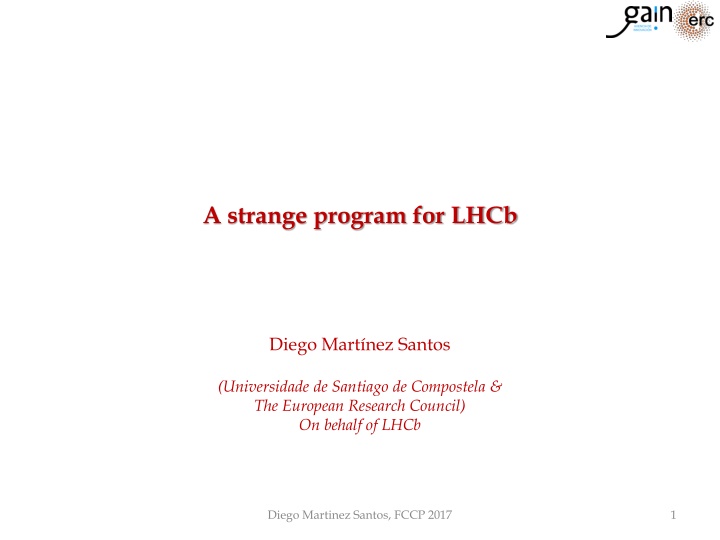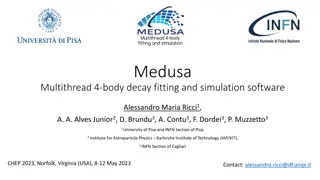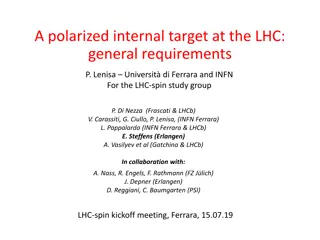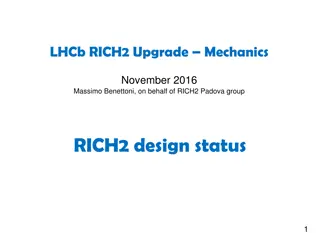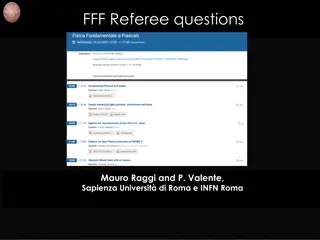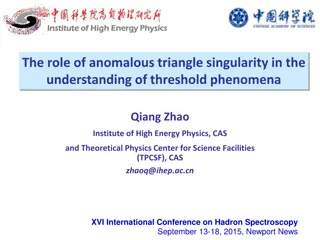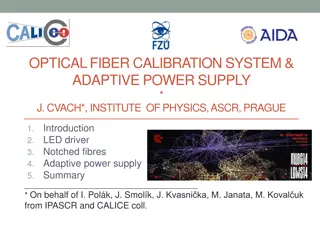A strange program for LHCb
The LHCb experiment at CERN focuses on b and c decays, with a unique emphasis on strangeness production. Diego Martinez Santos presents insights and updates on the trigger system, addressing bottlenecks and potential upgrades for improved efficiency and performance. The examination of data from 2011 and 2012 showcases advancements and challenges in the quest for optimal results.
Download Presentation

Please find below an Image/Link to download the presentation.
The content on the website is provided AS IS for your information and personal use only. It may not be sold, licensed, or shared on other websites without obtaining consent from the author.If you encounter any issues during the download, it is possible that the publisher has removed the file from their server.
You are allowed to download the files provided on this website for personal or commercial use, subject to the condition that they are used lawfully. All files are the property of their respective owners.
The content on the website is provided AS IS for your information and personal use only. It may not be sold, licensed, or shared on other websites without obtaining consent from the author.
E N D
Presentation Transcript
A strange program for LHCb Diego Mart nez Santos (Universidade de Santiago de Compostela & The European Research Council) On behalf of LHCb Diego Martinez Santos, FCCP 2017 1
Introduction LHCb experiment at LHC Designed mostly for b and c decays But there is also an ~infinite strangeness production at LHC Infinite production times zero efficiency requires L Hopital We still manage to get world best results Major improvements in the trigger for s decays are being done The results I m going to show correspond to Run I data 2011: 1fb-1 @ 7 TeV 2012: 2fb-1 @ 8 TeV Diego Martinez Santos, FCCP 2017 2
Trigger system: status and prospects Main bottleneck for K. Can t be changed L0 (Hardware) HLT1 (Software) Not designed for K, but flexible. K triggers being implemented HLT2 (Software) 3
Trigger system: status and prospects Main bottleneck for K. Can t be changed L0 (Hardware) HLT1 (Software) Not designed for K, but flexible. K triggers being implemented HLT2 (Software) (2011) ~ 1-2% (2016) improved HLT1,2 ~ 15% Maximum possible ~30% (L0 won t allow more) 4
Trigger system: status and prospects Main bottleneck for K. Can t be changed L0 (Hardware) LHCb Upgrade HLT1 (Software) HLT Not designed for K, but flexible. (Software) K triggers being implemented HLT2 (Software) (Note: This logo may not be official) (2011) ~ 1-2% (2016) improved HLT1,2 ~ 15% Maximum possible ~30% (L0 won t allow more) 5
Trigger system: status and prospects Main bottleneck for K. Can t be changed L0 (Hardware) LHCb Upgrade HLT1 (Software) HLT Not designed for K, but flexible. (Software) K triggers being implemented HLT2 (Software) (Note: This logo may not be official) (Upgrade) ~ 80-100%? Simulation studies show that rate would be under control (2011) ~ 1-2% (2016) improved HLT1,2 ~ 15% Maximum possible ~30% (L0 won t allow more) V. Chobanova et al, CERN-LHCb-PUB-2016-017 6
Rare decays of strange particles Proof of principle SM prediction: BR(KS ) = (5.1 1.5)x10-12 KS sensitive to different physics than KL (see JHEP 0401 (2004) 009) JHEP 0401 (2004) 009 JHEP 01 (2013) 090 LHCb performed a search using 1fb-1 : JHEP 01 (2013) 090 BR(KS ) < 9(11)x10-9 @90(95)%CLs We manage to get world best destpite low trigger efficiency Diego Martinez Santos, FCCP 2017 7
KS full Run-I analysis arXiv:1706.00758 [hep-ex] Update with 2012+ 2011 data Events classified using a BDT trained against combinatorial background Dedicated muon identification algorithm trained against KS Mass resolution 4 MeV 8
KS full Run-I analysis arXiv:1706.00758 [hep-ex] Update with 2012+ 2011 data Events classified using a BDT trained against combinatorial background Dedicated muon identification algorithm trained against KS Mass resolution 4 MeV Background KL negligible: (down to 10-11 precision) K : negligible p removed by a cut in the Armenteros-Podolanski plot. Combinatorial background KS double misid 9
KS full Run-I analysis arXiv:1706.00758 [hep-ex] Event yield extracted from a maximum likelihood fit in BDT categories Yield translated to BR via normalization to KS decays KS combinatorial 10
KS full Run-I analysis arXiv:1706.00758 [hep-ex] Event yield extracted from a maximum likelihood fit in BDT categories Yield translated to BR via normalization to KS decays Upper limit obtained integrating the posterior probability, using 2011 result as prior probability BR< 8 (10)x10-10 @90(95)%CL KS combinatorial 11
KS prospects -9] 1 BR (KS-> ) limit at 95%CL [x10 D. Martinez Santos, FPCP 17 Extrapolating from Run-I result The most interesting region can be achieved by LHCb upgrade with trigger improvements 0.1 Theoreticaly more interesting 0.01 SM Starting to investigate tagged decays, which would allow to access NP in the KS-KL interference [D Ambrosio&Kitahara https://arxiv.org/abs/1707.06999] 1E-3 0 50 100 150 200 -1] 250 300 TRIGL [fb LHCb-upgrade Phase-II-upgrade? Diego Martinez Santos, FCCP 2017 12
p full Run-I analysis LHCb-CONF-2016-013 Diego Martinez Santos, FCCP 2017 13
The HyperCP evidence The HyperCP collaboration found evidence for p decays, and provided a BR: This evidence had wide relevance since all 3 observed events had the same dimuon invariant mass (214 MeV) This suggested the existence of a new neutral particle at that mass Diego Martinez Santos, FCCP 2017 14
p full Run-I analysis The background discrimination LHCb-CONF-2016-013 A Boosted Decision Tree (BDT) is trained against combinatorial background: Signal proxy: Simulation Background proxy: same sign muons 15
p full Run-I analysis The control samples LHCb-CONF-2016-013 Two main control samples : used to calibrate mass resolution and peak position p : Used for normalization of the signal yield (translate yields into BR s) 16
p full Run-I analysis The preliminary results LHCb-CONF-2016-013 p : Found 4 evidence in one of the trigger categories (but no normalization) X : Found no evidence for the 214 MeV particle BR( p ) < 6.3x10-8 95% CL in the trigger category with available normalization 17
KS 0 sensitivity study CERN-LHCb-PUB-2016-017 Diego Martinez Santos, FCCP 2017 18
Why? (KL0 and ED) One of these important s-d transitions is KL 0 ~ 1 order of magnitude variation of the BR in models with Extra Dimensions Randall-Sundrum model M. Bauer et al, JHEP 1009:017,2010, arXiv:0912.1625 [hep-ph] Diego Martinez Santos, FCCP 2017 19
Why? (KL0 and ED) One of these important s-d transitions is KL 0 ~ 1 order of magnitude variation of the BR in models with Extra Dimensions Problem: The SM prediction is not too precise, which makes hard to distinguish small BSM effects from SM uncertainties Randall-Sundrum model M. Bauer et al, JHEP 1009:017,2010, arXiv:0912.1625 [hep-ph] Diego Martinez Santos, FCCP 2017 20
Why? (KS0 and SM errors on KL0) Dominant uncertainty, that makes difficult potential BSM interpretation of KL 0 It comes from the experimental uncertainty on BR(KS 0 ) measured by NA48 NA48 ~50% relative error Improved measurements of BR(KS will translate into improved BSM constraints from KL 0 ) 0 21
KS 0 sensitivity study V. Chobanova et al, CERN-LHCb-PUB-2016-017 KS 0 is searched for in two channels: In order to reconstruct the kaon mass for PARTIAL: 0 ( ) : hereafter FULL (low eff.) 0 mass PDG ?? 0 : hereafter PARTIAL ?? ?= ?? ?. The only unknown is ?? But statistically is 10GeV 0 p p Diego Martinez Santos, FCCP 2017 22
KS 0 sensitivity study V. Chobanova et al, CERN-LHCb-PUB-2016-017 Normalize yields to KS sensitivity to BR PARTIAL channel FULL channel LHCb HL-LHC 100 fb -1 100 % eff or 300 fb -1 33 % eff LHCb Upgrade, 100 % eff 23
KS +-ee sensitivity study C.Marin et al, CERN-LHCb-PUB-2016-016 Based on simulation: Expected a signal yield of +280 ? = 120 100 For the full Run-I dataset Expected background yield is not well known yet Diego Martinez Santos, FCCP 2017 24
Ongoing/future studies K+ mass Semileptonic hyperon decays Kaons from decays ( factory mode) K X0 , (X whatever neutral system: eg ) K X0 (X whatever neutral system: eg sterile neutrino) Workshop in 2013 and 2017 to discuss with TH community https://indico.cern.ch/event/280883/overview link For info in future workshops you can subscribe to rare-N-strange_at_cern_dot_ch Diego Martinez Santos, FCCP 2017 25
Conclusions There is an LHCs community in the LHCb village Trigger is constantly improving We aim for LHCb upgrade to reach efficiencies s as high as for b s Available measurements for: p , BR(KS ) Published prospects for KS 0 , KS + -ee Some more channels in our TODO list Workshops to discuss with the TH community Diego Martinez Santos, FCCP 2017 26
Backup Diego Martinez Santos, FCCP 2017 27
Lifetime acceptance and KL background KL and KS are distinguishable only by the decaytime and that is in theory. In practice, LHCb decaytime acceptance is not great for kaons ? ? ~? ?? With 5x s (>> L). This makes the two lifetime distributions to look similar But the overall efficiency ratio is of course different And makes KL to become a negligible background for the current level of precision But can be relevant when we approach the 10-11 level = O(10-3) Diego Martinez Santos, FCCP 2017 29
Normalization of event yield Converting a signal yield into a branching ratio ??0 production crossection Absolute efficiency ??0 ??? = ? ??0 ? ??0 ??? ?? Integrated luminosity Diego Martinez Santos, FCCP 2017 31
How? (normalization of event yield) Converting a signal yield into a branching ratio ??0 production crossection Absolute efficiency ??0 ??? = ? ??0 ? ??0 ??? ?? Integrated luminosity ??0 ??? ??0 ?? =? ??0 ? ??0 ??? ?? ? ??0 ? ??0 ?? ? ? Very well known (69.20 0.05)% Introduce in the ntuples a ??0 ?? decays counter Diego Martinez Santos, FCCP 2017 32
Dilepton mass distribution Take formulae from hep-ph/9808289 z= m2 d /dm = 2m d /dz Diego Martinez Santos, FCCP 2017 33
Remind of Bmm sensitivity Diego Martinez Santos, FCCP 2017 34
B mesons We check that we get right the expected increase of B meson yields (i.e, a factor ~2) B0s B0d B+/- Diego Martinez Santos, FCCP 2017 35
D mesons For D mesons the increase is slightly smaller (~1.6- 1.7) D+ D- D0 Ds Diego Martinez Santos, FCCP 2017 36
Strange particles Increase for most of them is ~40% K0s, K0L ,K+/-/0, (1020), K* As well as anti baryons , A bit less for baryons (note: baryons, not anti- baryons) However, the momentum is also different w.r.t 7 TeV. In particular, for the K0s decaying in the VELO the increase is only ~30% This is the number we really care for Ks studies Diego Martinez Santos, FCCP 2017 37
Leptons Increase in tau yiled consistent with ~ 2 , expected by the fact that most of them come from b s and c s + - Check with more stats if the asymmetry +/- is still there Electrons, muons Diego Martinez Santos, FCCP 2017 38
KS 0 sensitivity study The background discrimination V. Chobanova et al, CERN-LHCb-PUB-2016-017 As usual: BDT trained against combinatorial background Specific backgrounds: KS , KL , KS/L (negligible) Don t affect the sensitivity estimate Diego Martinez Santos, FCCP 2017 41
KS 0 sensitivity study Fit, FULL V. Chobanova et al, CERN-LHCb-PUB-2016-017 Diego Martinez Santos, FCCP 2017 42
KS 0 sensitivity study Fit, PARTIAL V. Chobanova et al, CERN-LHCb-PUB-2016-017 Diego Martinez Santos, FCCP 2017 43
The LHCb experiment Diego Martinez Santos, FCCP 2017 44
The LHCb experiment Forward spectrometer at P8 of LHC 2 < < 5 Best LHC detector for: Vertex resolution (~100 microns) Invariant mass resolution Access to moderately low p Particularly good a (di) muons Recorded luminosity: 3 fb-1 1 fb-1 at 7 TeV (2011) 2 fb-1 at 8 TeV (2012) ~2 fb-1 at 13 TeV (2015, 2016) Diego Martinez Santos, FCCP 2017 45
The LHCb experiment Forward spectrometer at P8 of LHC 2 < < 5 Best LHC detector for: Vertex resolution (~100 microns) Invariant mass resolution Access to moderately low p Particularly good a (di) muons Less good at reconstructing charged hadrons Recorded luminosity: 3 fb-1 1 fb-1 at 7 TeV (2011) 2 fb-1 at 8 TeV (2012) ~2 fb-1 at 13 TeV (2015, 2016) Diego Martinez Santos, FCCP 2017 46
The LHCb experiment Forward spectrometer at P8 of LHC 2 < < 5 Best LHC detector for: Vertex resolution (~100 microns) Invariant mass resolution Access to moderately low p Particularly good a (di) muons Less good at reconstructing charged hadrons Recorded luminosity: 3 fb-1 Even less good at photons 1 fb-1 at 7 TeV (2011) 2 fb-1 at 8 TeV (2012) ~2 fb-1 at 13 TeV (2015, 2016) Diego Martinez Santos, FCCP 2017 47
The LHCb experiment Forward spectrometer at P8 of LHC 2 < < 5 Best LHC detector for: Vertex resolution (~100 microns) Invariant mass resolution Access to moderately low p Particularly good a (di) muons Less good at reconstructing charged hadrons Recorded luminosity: 3 fb-1 Even less good at photons 1 fb-1 at 7 TeV (2011) 2 fb-1 at 8 TeV (2012) ~2 fb-1 at 13 TeV (2015, 2016) Doesn t detect neutrinos Diego Martinez Santos, FCCP 2017 48
Rare decays of strange particles Making a new experiment inside LHCb LHCb collects world leading samples of b and c quark decays. Everything else is rejected because of bandwidth reasons (used to be) b and c https://encrypted-tbn3.gstatic.com/images?q=tbn:ANd9GcSAEoYkNxEZqSCNRf3snmqR9TJt71IplwTOvWhbn8hL3nRZWkNMNBVKja8 b , c , s etc rest s LHC LHCb However, if BSM above few TeV (LHC energy scale), s-hadron decays are very important (very sensitive to non-MFV). But most of them are lost ! Diego Martinez Santos, FCCP 2017 49
Rare decays of strange particles Proof of principle SM prediction: BR(KS ) = (5.1 1.5)x10-12 KS sensitive to different physics than KL (see JHEP 0401 (2004) 009) JHEP 0401 (2004) 009 JHEP 01 (2013) 090 LHCb performed a search using 1fb-1 despite low trigger performance: JHEP 01 (2013) 090 BR(KS ) < 9(11)x10-9 @90(95)%CLs We manage to get world best destpite low trigger efficiency Diego Martinez Santos, FCCP 2017 50
